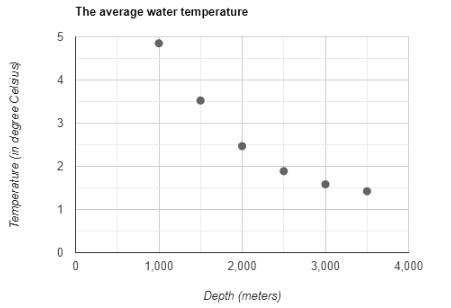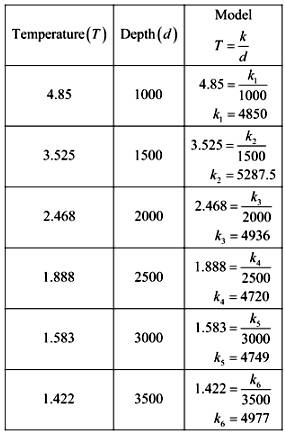
(a)
The
(a)
Answer to Problem 71E
The value gets decreases continuously based on the temperature and depth.
Explanation of Solution
Given information:
The ordered pairs are given with the average water temperature C in degree Celsius at several depths d in meters in the Indian Ocean.

Formula used:
The depth in meters is plotted against the x-axis and the temperature is plotted in y-axis.
Calculation:
With the help given data sketch a scatter plot by using graph utility:

Conclusion:
The value gets decreases continuously based on the temperature and depth.
(b)
The direct variation model or an inverse variation model better fits the data.
(b)
Answer to Problem 71E
The value of model get increases continuously.
Explanation of Solution
Given information:
The ordered pairs are given with the average water temperature C in degree Celsius at several depths d in meters in the Indian Ocean.

Formula used:

Calculation:
Yes, the data appears to be modelled by the inverse proportion model.

Conclusion:
The value of model
(c)
The value of
(c)
Answer to Problem 71E
The value of is
Explanation of Solution
Given information:
The ordered pairs are given with the average water temperature C in degree Celsius at several depths d in meters in the Indian Ocean.

Formula used:
Calculation:
The mean value of k will be
Mean,
Thus, the value of is
Conclusion:
The value of is
(d)
The model for the depth at which the water temperature is
(d)
Answer to Problem 71E
The approximate the depth is at 1640 meters at which the water temperature is 3°C.
Explanation of Solution
Given information:
The ordered pairs are given with the average water temperature C in degree Celsius at several depths d in meters in the Indian Ocean.

Formula used:

Calculation:
Use the model derived in part
Thus, the approximate the depth is at 1640 meters at which the water temperature is 3°C.
Conclusion:
The approximate the depth is at 1640 meters at which the water temperature is 3°C.
Chapter 1 Solutions
EBK PRECALCULUS W/LIMITS
- A 20 foot ladder rests on level ground; its head (top) is against a vertical wall. The bottom of the ladder begins by being 12 feet from the wall but begins moving away at the rate of 0.1 feet per second. At what rate is the top of the ladder slipping down the wall? You may use a calculator.arrow_forwardExplain the focus and reasons for establishment of 12.4.1(root test) and 12.4.2(ratio test)arrow_forwarduse Integration by Parts to derive 12.6.1arrow_forward
- Explain the relationship between 12.3.6, (case A of 12.3.6) and 12.3.7arrow_forwardExplain the key points and reasons for the establishment of 12.3.2(integral Test)arrow_forwardUse 12.4.2 to determine whether the infinite series on the right side of equation 12.6.5, 12.6.6 and 12.6.7 converges for every real number x.arrow_forward
- use Corollary 12.6.2 and 12.6.3 to derive 12.6.4,12.6.5, 12.6.6 and 12.6.7arrow_forwardExplain the focus and reasons for establishment of 12.5.1(lim(n->infinite) and sigma of k=0 to n)arrow_forwardExplain the focus and reasons for establishment of 12.5.3 about alternating series. and explain the reason why (sigma k=1 to infinite)(-1)k+1/k = 1/1 - 1/2 + 1/3 - 1/4 + .... converges.arrow_forward
 Calculus: Early TranscendentalsCalculusISBN:9781285741550Author:James StewartPublisher:Cengage Learning
Calculus: Early TranscendentalsCalculusISBN:9781285741550Author:James StewartPublisher:Cengage Learning Thomas' Calculus (14th Edition)CalculusISBN:9780134438986Author:Joel R. Hass, Christopher E. Heil, Maurice D. WeirPublisher:PEARSON
Thomas' Calculus (14th Edition)CalculusISBN:9780134438986Author:Joel R. Hass, Christopher E. Heil, Maurice D. WeirPublisher:PEARSON Calculus: Early Transcendentals (3rd Edition)CalculusISBN:9780134763644Author:William L. Briggs, Lyle Cochran, Bernard Gillett, Eric SchulzPublisher:PEARSON
Calculus: Early Transcendentals (3rd Edition)CalculusISBN:9780134763644Author:William L. Briggs, Lyle Cochran, Bernard Gillett, Eric SchulzPublisher:PEARSON Calculus: Early TranscendentalsCalculusISBN:9781319050740Author:Jon Rogawski, Colin Adams, Robert FranzosaPublisher:W. H. Freeman
Calculus: Early TranscendentalsCalculusISBN:9781319050740Author:Jon Rogawski, Colin Adams, Robert FranzosaPublisher:W. H. Freeman
 Calculus: Early Transcendental FunctionsCalculusISBN:9781337552516Author:Ron Larson, Bruce H. EdwardsPublisher:Cengage Learning
Calculus: Early Transcendental FunctionsCalculusISBN:9781337552516Author:Ron Larson, Bruce H. EdwardsPublisher:Cengage Learning





